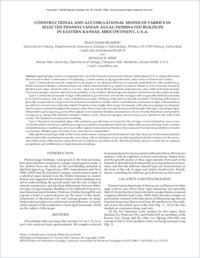Constructional and accumulational modes of fabrics in selected pennsylvanian algal-dominated buildups in eastern Kansas, Midcontinent, U.S.A.
- Samankassou, Elias Geology and Paleontology Unit, Department of Geosciences, University of Fribourg, Switzerland
- West, Ronald R. Department of Geology, Kansas State University, Manhattan, Kansas, USA
-
2003
Published in:
- Permo-Carboniferous Carbonate Platforms and Reefs. - 2003, p. 219-237
English
Algal buildups from five stratigraphic intervals in the Pennsylvanian of eastern Kansas, Midcontinent, U.S.A., display three basic fabrics based on their: a) dimension, b) morphology, c) fossil content, d) algal growth forms, and e) nature of framework cavities. Type 1. Constructional mounds composed of cup-shaped in situ algal growth forms are typically small bioherms, either isolated (e.g., Frisbie Limestone Member) or thickened intervals within carbonate banks (e.g., Sniabar Limestone Member), and are basically formed by phylloid green algae. Fossil diversity is very low. Mud and cement fill the abundant small intercup voids within individual mounds. Calcareous sponges, crinoids, and bryozoans, probably cavity dwellers, fill the larger intermound cavities between the smaller mounds. Type 2. Constructional mounds of algae with undulatory growth forms are basically red algae with recognizable thalli characteristics of Archaeolithophyllum, and, only rarely, of phylloid green algae. Buildups of this kind are laterally persistent. Thickening of the banks is generally recognizable at a large scale (ten of meters to kilometers). Smaller, meter-scale bioherms constructed of algae with undulatory growth forms do not occur in the sites studied. Fossil diversity is higher than in type (1) mounds, with calcareous sponges, brachiopods, and bryozoans common throughout the mound, rather than exclusively in cavities between small mounds of the type 1 cup-shaped algae. When built by green algae (e.g., parts of the Captain Creek Limestone Member), mounds have a lower diversity than those constructed by red algae (e.g., Spring Hill Limestone Member). Solitary corals, calcareous sponges, and bryozoans occur attached to the walls of the cavities. The abundance of open pores is striking. Type 3. Mounds of accumulated algae with undulatory growth forms are formed by the red algae Archaeolithophyllum missouriense, Archaeolithophyllum lamellosum, and the green alga Eugonophyllum. Depositional relief is not visible on the outcrop, but large-scale variations in bank thickness are notable (e.g., lower part of the Captain Creek Limestone Member). Bryozoans and Thartharella (a probable worm tube) are common. Multiple types of cavities occur, and most are cement-filled. Although the mound types differ in their form, fossil content, and type and distribution of voids, they share an overall common peloidal clotted matrix that accumulated in specific areas, along with an abundance of gravity-defying peloidal micritic structures in the matrix, and of thin crusts within marine cement that may be related to microbial activity. Microbes probably played a crucial role in carbonate precipitation and in lithification of algal-dominated buildups.
- Faculty
- Faculté des sciences et de médecine
- Department
- Département de Géosciences
- Language
-
- English
- Classification
- Geology
- License
- License undefined
- Identifiers
-
- RERO DOC 5050
- DOI 10.2110/pec.03.78.0219
- Persistent URL
- https://folia.unifr.ch/unifr/documents/299848
Statistics
Document views: 170
File downloads:
- 1_samankassou_cam.pdf: 240
